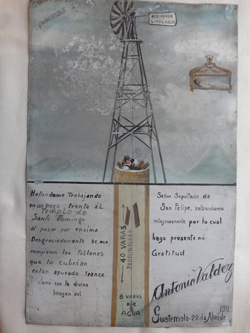Student-curated exhibition opens Friday
The eight graduate and undergraduate students in the seminar "Visual and Material Culture in Colonial Spanish America" selected their objects based on personal interests from several local private collections. The art is representative of much of the region, including colonial, republican, and contemporary pieces from Mexico, Guatemala, Ecuador, Peru, and Paraguay. From textiles, costumes, and altar decorations to painting, sculpture, and various material expressions of devotion, Merging Souls draws together diverse objects into an informative and fun experience.
 The exhibit testifies to the hybrid nature of local devotion in communities throughout Latin America. The region's history begins with objects from pre-Columbian cultures, including the Incas and the Mayas. The Spanish conquest in the early sixteenth century forced a cultural evolution as indigenous cultures were subjected to Spanish cultural impositions and hegemony. However, many of the objects in the exhibition come from communities in which Spanish is the secondary language, and indigenous languages are the principal forms of communication. The study of these objects demonstrates that, far from a singular, monolithic dominance, Spanish and European forms and ideas combined with earlier indigenous beliefs and practices. The Spanish introduced Catholicism in an effort to erase indigenous religious forms, but the result was an interesting and often unique mix of traditions and beliefs; this integration is also present in linguistic modes and everyday cultural practices and material objects.
The exhibit testifies to the hybrid nature of local devotion in communities throughout Latin America. The region's history begins with objects from pre-Columbian cultures, including the Incas and the Mayas. The Spanish conquest in the early sixteenth century forced a cultural evolution as indigenous cultures were subjected to Spanish cultural impositions and hegemony. However, many of the objects in the exhibition come from communities in which Spanish is the secondary language, and indigenous languages are the principal forms of communication. The study of these objects demonstrates that, far from a singular, monolithic dominance, Spanish and European forms and ideas combined with earlier indigenous beliefs and practices. The Spanish introduced Catholicism in an effort to erase indigenous religious forms, but the result was an interesting and often unique mix of traditions and beliefs; this integration is also present in linguistic modes and everyday cultural practices and material objects.Students in the seminar have worked together to learn and discuss the politics of display, particularly in terms of exhibiting cultures.
"One of the main concerns is to refrain from exoticizing the cultures we are exhibiting," says Molly King '11. "The art is different; but it has so much to illustrate about these communities and their spiritual and artistic practices. We want to bring communities and cultures together, rather than underline the differences."
Graduate student Laurel Daen, who is interested in pursuing curatorial work, comments that she's learned a great deal from the process of creating a museum exhibit.
"There's so much that goes into an exhibition -- researching and selecting objects, writing wall text, publishing educational materials -- and it's been great to work with the class and the folks at the Muscarelle on all aspects of the project. I look forward to seeing our final product in a few weeks," she said.
Sarah Stanley '11 has been able to pursue her interest in textiles through her work on the exhibit, a topic that is harder to find in the art history department.
"The exhibit has provided me with an incredible opportunity not only to learn more about textiles within the cultural context of Guatemala, but also to experience some of the issues that arise when trying to display these objects in a museum setting," she said. "Through this exhibit I was able to really gain a greater appreciation for both the cultural and curatorial sides of textile studies."
The exhibit will open on Friday, April 23 at 7 p.m. and will be on display through the month of June. The students will present the results of their research at a symposium on Friday, April 30 at 3 p.m. in the main hall of the museum. The opening reception and symposium are free and open to the William and Mary community. For more information, contact Molly L. King at mlking@email.wm.edu or Professor Susan V. Webster at svwebster@wm.edu.














